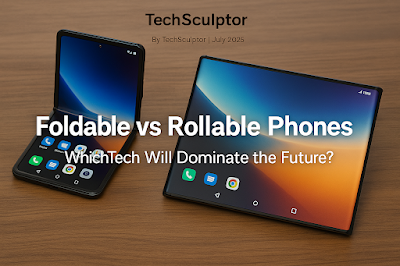By TechSculptor | July 2025
In the ever-evolving world of smartphones, two innovative form factors are battling for the future: foldable and rollable phones. Both designs offer futuristic aesthetics and groundbreaking functionality, but only one is likely to become the mainstream standard. So, which tech will dominate the next era of mobile devices?
Let’s break it down.
🔄 Foldable Phones: The Flexible Powerhouses
✅ What Are Foldables?
Foldable phones use flexible OLED displays and hinges to let the device fold in half—either horizontally (like a clamshell) or vertically (book-style). Popular examples include the Samsung Galaxy Z Fold5, Google Pixel Fold, and OnePlus Open.
🌟 Pros of Foldable Phones
-
Bigger Screens in Smaller Pockets: Ideal for productivity and media consumption.
-
Multitasking: Seamless split-screen usage enhances user efficiency.
-
Mature Ecosystem: Foldables have a head start with multiple generations already in the market.
⚠️ Cons
-
Durability Concerns: Hinges and flexible screens are more prone to wear and tear.
-
Bulkier Designs: Even when folded, they can be thicker than traditional smartphones.
-
Price: Premium pricing still limits accessibility.
📜 Rollable Phones: The Expanding Contenders
✅ What Are Rollables?
Rollable phones feature a motorized or manual mechanism that expands the screen horizontally or vertically by unrolling the display. This creates a compact phone that transforms into a tablet-like device on demand.
Brands like Motorola, LG (prototype stage), and Samsung are actively experimenting with rollable concepts, although commercial releases are still limited.
🌟 Pros of Rollable Phones
-
Sleek and Compact: No hinge, no crease—just clean design.
-
On-Demand Screen Size: Screen expands only when needed, offering more flexibility.
-
Potentially More Durable: Fewer moving parts than foldables.
⚠️ Cons
-
Still Experimental: Most rollables are in concept or early prototype stages.
-
Unknown Long-Term Reliability: The rolling mechanism is new and unproven in daily use.
-
Higher Development Cost: Which may delay mass production and affordability.
📊 Head-to-Head Comparison
| Feature | Foldable Phones | Rollable Phones |
|---|---|---|
| Availability | Widely available | Limited / Prototype |
| Durability | Moderate (hinge issues) | TBD (mechanism reliability) |
| Screen Innovation | Foldable OLED | Expandable OLED |
| User Experience | Proven, stable | Promising, but untested |
| Cost | High | Potentially higher initially |
🔮 The Future: Who Will Win?
As of mid-2025, foldables lead the race with more real-world usage, mature software, and a growing user base. However, rollables have the potential to revolutionize form factor design once technical challenges are overcome.
The likely scenario? Foldables will dominate the near-term, while rollables could disrupt the market in the longer run—possibly merging with foldable concepts to create hybrid devices.
🧠 Final Thoughts: Sculpting the Future of Phones
At TechSculptor, we believe innovation isn’t a race with one winner. It’s a dynamic evolution. Foldables are refining usability, while rollables are reimagining what's possible. As these devices evolve, the real winner will be the user—benefiting from a more versatile and immersive mobile experience.
Which side are you on—Team Fold or Team Roll?
Let us know in the comments below. And don’t forget to subscribe to TechSculptor for more future-forward tech insights.











0 Comments